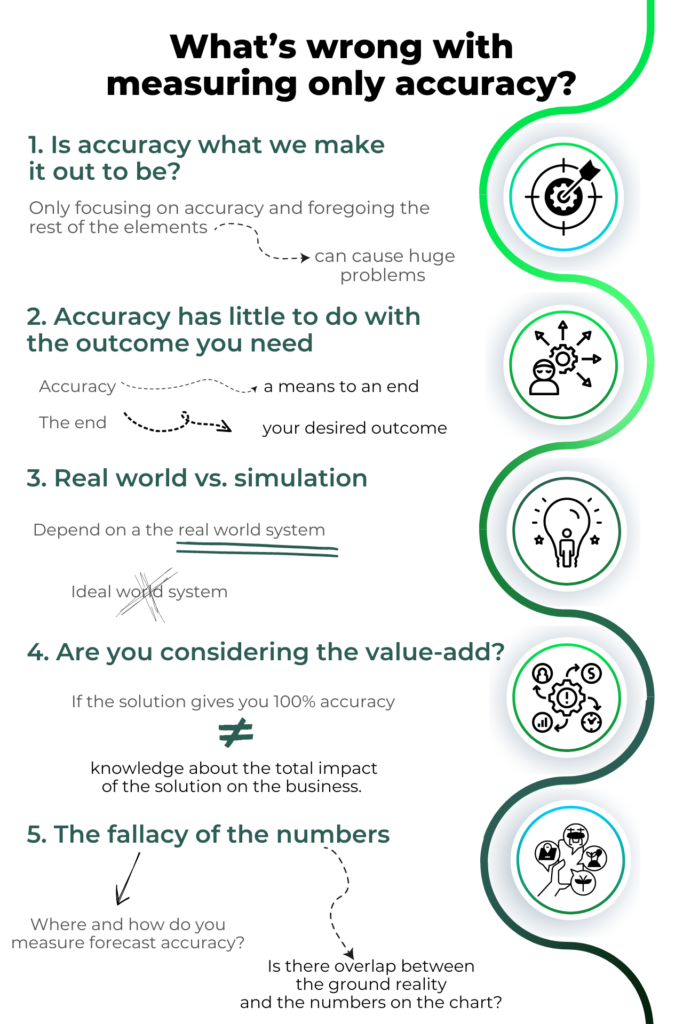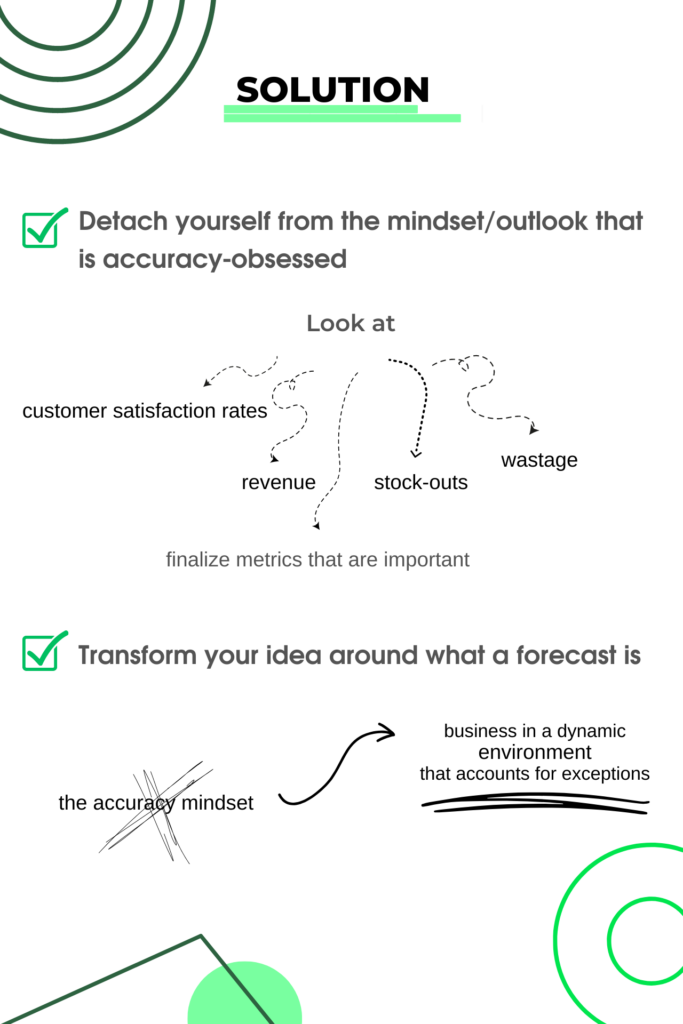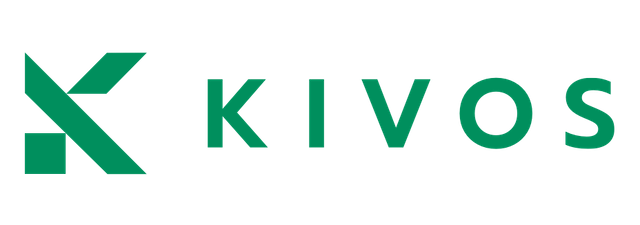#1 merchandise planning myth in retail: forecast accuracy is the end-all solution
The conversation around merchandise planning is plentiful, but often misleading.
Bold statement to start with, I know. But let me elaborate: the concept of merchandise planning has been around long enough for the industry to see some shifts. A trend I see popping up every-so-often that happens to be in full-swing these days is the fixation with accuracy in forecasting.
Over the years, multiple people have talked about it, re-invented it, bettered it and led with it. Lots of providers distinguish themselves on the basis of how accurate their systems are, and quite a few retailers have fallen right into the trap. But what is this hyper-focus on accuracy and what does it mean for users?
This is exactly what I discuss in detail below.
What’s wrong with measuring only accuracy?
1. Accuracy is simply a feature or an element:
2. Little to do with the outcome you need:
3. Real world vs. simulation:
4. Value-add:
5. The fallacy of the numbers:
Your merchandise planning solution should help you take calculated risks and win big.
Kivos does all the heavy-lifting for you, so you can focus on your $$$ numbers.
Let’s start with this:
Why is accuracy in forecasting such a fan-favorite? Two reasons:
- Easy to measure: this means that instead of focusing on real numbers that matter but are hard to measure like revenue, profitability and growth, retailers measure accuracy that is easily measured.
- Easy to disguise: Because retailers keep measuring accuracy, providers keep portraying accuracy as the ultimate metric. The higher the accuracy, the better the solution. This mindset distracts retailers from addressing the real problems inside the supply chain.
It all starts when retailers assume that the route to better supply chain performance is through more accurate forecasts. This linear thinking invariably leads to companies splurging on fancy systems that produce the most accurate forecasts without moving revenue numbers up even by an inch. And this leads to an unending cycle.
So, why is accuracy-obsession such a big problem?
Supply chain performance is a lot more nuanced than what a quick-fix solution can solve. Obsessing over accuracy is taking your attention away from the real problems that are plaguing retail.
What’s wrong with measuring only accuracy?
Merchandise planning solutions mainly help you compare the predictions with historical outcomes. When the two match each other, you know the platform/service has done a good job. Because accuracy is such an easy metric to measure, it has become the default one.
1. Is accuracy what we make it out to be?
Accuracy is the bare minimum that a merchandise planning solution provides. And yet, more often than not, 8 out of the 10 platforms/services on the market obsess over accuracy and hand out seemingly accurate, single-number forecasts.
But seemingly-accurate and precisely accurate are two different things. Let me elaborate:
When you look at the weather forecasts in your local area, do you always know for sure whether it’s going to rain or not? Such high-tech, advanced machines also don’t hand you a yes or no answer. They tell you the probability of it raining.
Similarly, solutions that give you deterministic values are giving you yes/no answers. These answers may look accurate, but they aren’t. What more? They take away your decision making power. With stochastic forecasting, you get to control the amount of inventory according to the variables and choose the best decision based on the outcomes you want.
And even then, accuracy is simply one of the pie’s ingredients. But without the other ingredients, you’re not even going to have a pie! Accuracy can lead you to drive better decisions, but only focusing on accuracy and foregoing the rest of the elements can cause huge problems down the road.
2. Accuracy has little to do with the outcome you need:
Say Kate, the inventory manager at a retail business, is facing constant stock-outs. They happen to consistently store fewer products than necessary to avoid wastage and over-stocking. Kate recognizes that they’re losing valuable customers to these stock-outs and needs a better solution.
In this case, Kate doesn’t need an accurate merchandise planning solution, she needs a forecast that doesn’t rely on deterministic values and shows her the optimum level at which she can run the least risk of overstocking while avoiding stock-outs. She needs all possible values weighted with the probability to happen, not one single value that gives her no further insight.
Most merchandise planning solution vendors wrongly assume that forecast accuracy is the end all-be all solution to common merchandising problems. But clearly, that is not the case.
Ask yourself this: What do I need out of my forecasting solution? Is it accuracy? NO. It could be:
- Fewer stock-outs
- Better inventory optimization
- Higher profitability
- Better customer satisfaction rates
Accuracy is simply a means to an end. The end being your desired outcome.
3. Real world vs. simulation:
In a controlled environment, things are predictable and straight-forward. This is because you get to choose which factors to model and which ones to leave out the equation. For example, the fact that your suppliers have a contractual lead time of 5 days, which you then use in lab tests, may not be true in real life. It may not be possible for your supplier to deliver in 5 days 100% of the time.
In the “ideal world” environment, it is possible to achieve somewhat accurate results. But in the real world, there are multiple variables.
Your suppliers, external partners and the business environment are all highly volatile. Dynamic consumer trends, competitor activities, economic recession or growth, natural calamities, the weather, there are just too many factors that come into play here. Then, it becomes important to depend on a system that models the real world, not the ideal one.
4. Are you considering the value-add?
Sure, accurate forecasts help with replenishment and getting things in the right places at the right times, but deterministic forecasts can only take you so far. Ultimately, the success of a merchandise planning platform/service depends on the value it provides. No matter how accurate the tool/process, it cannot replace value, because value refers to the total revenue it brings in.
“Value” implies that there is a positive economical/financial impact on the business, so even if the solution gives you 100% accuracy (which isn’t even possible), that says absolutely nothing about the total impact of the solution on the business.
5. The fallacy of the numbers:
Forecast accuracy could be defined as the forecast numbers against actual sales. But how detailed do you go as far as levels of accuracy are concerned? Are you implementing it on the product, location, day- level? If you have too many products, do you move a level up and do it according to product groups, categories, districts? Or do you cumulatively measure it weekly/monthly?
If you go too detailed, you’re going to have billions of data points and after a point, it’s going to be next to impossible to make sense out of it all. Go too high-level and accuracy goes for a toss. You could aggregate it, but since execution happens at a much lower level, the “real” problem will never be highlighted and solved.
For example, it is common for organizations to review forecast accuracy or performance at category or department level, but place orders for each item in that category or department separately per supplier in reality.
So, how does the averaged forecast accuracy of a product category connect to the forecast accuracy of the single product? It simply doesn’t. At least not in a meaningful manner.
When we aggregate, we tend to cancel out details that matter. In this way, an over forecast case and an under forecast case could become a good forecast as an average, similar to how two wrongs make a right. Ultimately, this ends up giving us very little insight.

To avoid the above headaches, the three key questions about forecast accuracy you need to ask are:
- Where do you measure it?
- How do you measure it?
- Is there overlap between the ground reality and the numbers on the chart?
So, what’s the solution?
As disappointing as it may sound, there is no one winning factor that can help you. There are multiple elements that need to work together to create the perfect solution for you. And accuracy is just the first step to it.

The journey to making better merchandise planning solutions starts with detaching yourself from the mindset/outlook that is accuracy-obsessed. Find out the actual numbers that matter to you. Look at your customer satisfaction rates, stock-outs, wastage, revenue and finalize metrics that are important.
Secondly, the idea around what a forecast is, and what it should look like needs to transform. When we talk about time-series forecast, which is one of the most popular types of forecasting, the univariate version only accounts for a single data series. Averaging things out skews data and doesn’t help put things into perspective.
If business functions as usual, the forecast is right. But, we already know that business is hardly ever usual. If the variables act up, business suffers. You may face stock-outs and if that happens enough times, you might see a dip in customer satisfaction. You may miss out on opportunities to upsell and cross sell.
You don’t need an accurate number for “business as usual”, you need multiple numbers for business in a dynamic environment that accounts for exceptions, i.e. you need probabilities for the multiple outcomes.
How do you make that your reality? Abandoning the accuracy mindset and adopting a solution that takes care of it all for you.
Your merchandise planning solution should help you take calculated risks and win big.
Kivos does all the heavy-lifting for you, so you can focus on your $$$ numbers.


